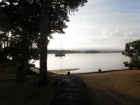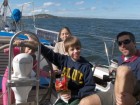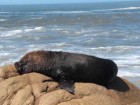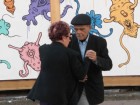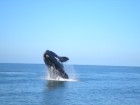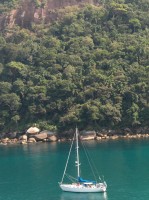Sailing with En Passant
| Vessel Name: | En Passant |
| Vessel Make/Model: | KP44 |
| Hailing Port: | Galway |
| Crew: | Mark Norman |
| About: |
21 February 2012
Guyana
The other morning the bonus was the snout of a black caiman for just a moment before it slid under the red-brown water without a ripple. The day before it had been the discovery of a tree in fruit, a few yards from the water's edge that gave me a clear view of the flock of white fronted toucans hopping [...]
28 October 2011 | Natal
Brasil Rond Two
July on the coast of Uruguay reminded me far too much of the east coast of Ireland in November. The days were bright but it was very chilly every time the wind came off the sea. I had just arrived back to cold shock after a five week passage to Grenada.
20 December 2010 | Montevideo, Uruguay
Uruguay First Impressions
The last city that we really engaged with was Las Palmas de Gran Canaria and that was a year ago. Since then it has been islands, bays and for the most part anchorages. We are now tied bow and stern, proa a popa , to mooring buoys that hold us parallel to the pier here in Peurto Buceo. We are on one [...]
12 October 2010 | Montevideo, Uruguay
Leaving Pasadise
Time was standing still. The weather waxed and waned as did the moons but we had really let go of contemporary time. The nearest thing to an effective calendar was the level of food in our huge double level fridge. We keep a week's supply of fresh on the top level, and when that has been consumed you [...]
Guyana
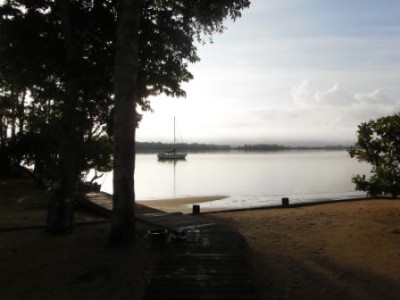
We are up the Essiquibo river almost fifty miles from the sea. Dawn dingy rides up stream so that we can drift back down along the bank watching and listening to the rain forest have become part of our routine. The dawn light and sunrise are just too good to miss, so it is early to bed and early to rise for us and the rest of the river's inhabitants. These are mostly birds and animals as the sparse population is well spread out, up here above Bartica there are miles of pristine forested bank without a single habitation.
I am normally a creature most at home on blue water, happiest with swell and a good breeze but I have find the wonderful soft light and tranquillity of Guyana's easy to cruise river, the Essiquibo, wonderfully relaxing.
We left Natal in Brasil en route for Tobago. We took our first break at Ile's de Salut off French Guyana. The three islands (Royale, St. Josephs and Devil's Island) were all part of the prison colony made infamous by "Papillion". Now they are a low key tourist destination attracting cruise ships and day trippers from the space station town of Kourou just seven miles away.
The wild-life is very tame as the islands are protected. The animals are an odd mixture of local and introduced. The red rumped agotis seem quite at home with the feral cockerels and pheasants, after all there are enough mangos and coconuts to go around.
Part of the old prison is now a hotel and another of the old buildings houses an interesting museum that reminds you only too well of the terrible "solution" for political and ordinary prisoners that the French shared with other European countries in the past.
After a peaceful week on the good anchorage at Ile Royale we continued on in the light trades for Guyana. We are on a slightly tight schedule to rendezvous with family in Tobago before Christmas and so skipped over Suriname in favour of Guyana.
Armed with a copy of the Doyle cruising guide to Trinidad, Tobago and Guyana we entered the eastern or "ship channel" of the Essequibo estuary. We had passed the approach buoy an hour before low water and by the time we reached Parika had a strong flood tide with us which we rode almost all the way to Bartica. The only traffic in the forty miles were a few water taxis flying past with 150 and 200 hp on the back of fairly small light boats.
We were approached by one launch that was painted camouflage and were asked by the (we assumed) policeman aboard where we had come from and our destination. He told us of the upcoming general election and was happy to allow us to proceed to Bartica for clearance.
We anchored our first night off the Shankland's Resort but saw no sign of life ashore. After a really good sleep we motored the last few miles against the river and anchored off the "Stelling" or pier in Bartica. I dingied in and easily found the customs house where Nigel, the customs officer insisted on a visit out to check for contraband and explain the rules before he would clear us in. Customs clearance in hand we called in to the police station to see the immigration officer and finish the formalities. The police station is ringed with a high security fence, and the frontier feeling was completed by the "lads" calling out from between the bars of the lock up for cigarettes.
Bartica is a real cultural mix these days, Brazilian restaurants, beauty parlours and bars are popping up between the Hindu owned general stores and gold dealers. There are cows in the street, Indian style, but the street vendors are Rastas, West India style. We stocked up on some fresh and went back on-board for an early night. Some chance anchored close to waterfront bars that cater to Brazilian gold miners on a Friday night.
The next morning we move the four miles up to Baganara island where another small hotel or resort is located. Half of the island is still forested, the other half an air-strip, lawns and the hotel itself atop a sandy beach. We anchored just past the hotel building and when we went ashore were met by the manger Kurt and welcomed with a limeade and a briefing about the resort. Yachties are welcome just let the hotel know when you want to come ashore in case there are reclusive guests about !
We started our dawn habits the next morning and took a guided walk around the island at six o'clock. Our guide was young but very enthusiastic and knowledgeable about the birds, the howler monkeys and the sloth that we respectively, saw and heard.
The neat aluminium Ranke designed yacht moored to the bank a mile upstream drew me up for a visit the next day. As I pulled in to tie up the dingy my breath was taken away by the beautiful octagonal wooden house standing on the bank. Bernhard and his Guyanse wife Sharmilla welcomed me and showed me around the garden they have created in the rain forest clearing. It is very impressive for such a new garden but then that is the reward for hard work in the tropics, fast results. The magic ingredient is the organic compost that Bernard artfully creates from lawn mowing's, green trimmings and granite dust from the quarry a few miles upstream. I can vouch for how tasty all their produce is from the banana chips, to the golden apple juice and from the red berry jam to the hot, hot chutney to dip those banana chips into.
After a couple of peaceful days we headed further up river armed with waypoints from Bernhard. We took it nice and easy and poked our way another fifteen or so miles up before we ran out of water. The rapids were all around us but we found holding in a deep pool and enjoyed the evening parrot rucus as they come back to their river side roosts. It was this morning's dingy run that gave me sight of the cayman and after some torrential rain had passed we upped anchor and started back.
It was a more difficult run down with the current and I had to re-negotiate more than one. I let my guard down once we passed between two old channel buoys and found a lump of granite. We backed off all right but it certainly made we wish for clear blue water.
Bernhard and Sharmilla hosted us magnificently that night and the next day we passed below Bartica and crossed to the west side of the river to visit "Miss Joyce". We had been told about another cruising couple who had built a house on the riverside and were curious to meet them. Unfortunately her husband had passed away a few years ago and Joyce is now living alone there in another amazing riverside property. Her yacht "Mood Indigo" and her two wheaten terriers, Duke and Ellie keep her company.
We enjoyed our few days moored off her garden and were glad that we were able to help out a bit with some energy generating problems she was having and a bit of garden work. Joyce has certainly a wonderful spot on the river but it would not be my choice for long term living, especially living alone.
We anchored for our last night on the river twenty miles downstream from Bartica between the Lau Lau islands. This really was jungle cruising, not a sign of a human habitation just the evening parrots and the odd fish splashing in the water for company. A dawn start gave us five hours of ebb tide and we flew down the western channel. There was one seine net stretched almost all the way across the river to negotiate and then we were past the miles of fish trap stakes and in slightly greener water.
The trades tend to be light in here close to the continental shore but we had enough for a pleasant sail and were able to lay the top corner of Tobago on one tack. I had been expecting to make Charlotville sometime the morning of the second day but had to slow the boat down the second night to avoid entering in the dark.
Now we are officially in the Caribbean. It took a while, over three years but then what is the hurry.
Brasil Rond Two

But I had my “magic carpet” and it took me less than a week to have her well stocked up, a new AIS installed and the anchor windlass refitted after a service and all ready to go.
The fronts from the south were coming in regularly and the trick is to balance your need for a fair wind with the administration of the ports. The ports are closed whenever there is thirty knots of wind forecast, and the fronts normally last two or three days. Ideally you want to let the first day , often up to forty knots with rain, go through and then take the “train” of bright cold air of maybe twenty or twenty five knots behind it. The ports open on forecast not actual conditions and are often twelve hours behind the times.
My weather window opened and I went to get my clearance papers from the Prefectura. The officer on duty agreed to fill them but not to sign them as the port was closed. I then took the bus to the airport to get my passport stamped out with immigration and was back in Piriapolis in time for a last enormous pasta lunch in my favourite and incredibly cheap restaurant, the Alba. When I got back to the Prefectura office at two the port was officially open. I got my papers signed and headed back to the boat. Two hours later I let the ropes go disturbing a penguin as I went, definitely a sign to sail somewhere warmer.
My timing was good and I managed to get six hundred miles in four days from that weather “train” and by then I was in t-shirt and shorts, mission accomplished. Two days of light head winds and one days motoring and I was clearing into Brasil at Angra dos Reis in 25 degrees of sunshine.
I had a short two weeks around Ilha Grande and Paraty before my daughter Heather and her boyfriend were due. They flew into Rio and I had booked a transfer for them direct to Abrao on Ilha Grande. It worked a treat. They arrived so quickly that I missed them off the boat and we spent nearly an hour missing each other around the tiny village! Of coursed with visitors from Ireland came two days of rain, the first I had seen in two weeks.
Their visit flew with all the anchorages and walks that I had to show them. The third week I took advantage of a southerly day to go the 150 miles up to Buzios. It was hard on the crew as they did not have time to settle into a passage and it was a bit rolly.
Buzios is very chic for the Rio “set” in season. I was glad it was off season and my visitors were able to enjoy the beaches without huge crowds. The clear water and the turtles make for a very pleasant anchorage and we had company with an interesting German couple who had been onboard for eighteen years.
The weather gods were smiling for me and two days before my visitors were due to go home the next “train” north was due. Heather and Michael kindly agreed to spend their last two days with a Brazilian friend of mine and once they took the bus for Niteroi I bought some fresh and waited for a new crew member, Maggie, who was coming from Rio by bus. When she turned up late in the morning we headed straight out.
We had enough wind to get us up and past the Sao Tomé oilfields the first night and by the second day we were surrounded by humpback whales. They were blowing and breaching all around us. The wind was easing but I decided to keep sailing and we passed Abrolhas without stopping. The next night though we were be-calmed . We had made good time and I was patient enough to drop all sail and sit and wait for wind. We had about twenty hours to wait for a ruffle that became a breeze. The sailing just got better and better, fast and without a lot of sea, dolphins for company and tuna for dinner.
We arrived a few hours ahead of ourselves in Recife and picked up a buoy at the Pernambuco club down in the main harbour for a few hours sleep before we took the early morning tide up to Cabanga, the club that hosts the regatta to Fernando na Norhuna. It is not the prettiest location for a sailing club in the world, close by a main road and murky estuary water but it turned out to be a real oasis.
An oasis that was full of friendly members, helpful staff and great facilities. I left En Passant for two week, happy that she was completely secure and when I returned the quiet club had been transformed with the arrival of the fleet for the “REFENO”. There was work going on boats, safety inspections to pass, people to meet, group charascos (bar-b-qs) each evening where we all chipped in and Augusto , the larger than life , Argentinian, cooked all around him. The club too put on casual events for us. All in all it was a great two weeks of working hard preparing boats and partying.
I had been looking for crew for the run to Norhuna and I found three Brazilians via the clubs website. Liro was the only local one and he turned out to be a real gem, friendly, helpful and full of enthusiasm for his first sailing adventure. The other two flew in from Sao Paulo and on the day before the regatta, Clint a Californian came looking for a berth and found one with us.
Flag raising and naval bands, big official dinner accompanied by a very loud cover’s band and a final day of briefings. Saturday morning and this crew of mine had never set sail on En Passant before, good job that Clint had shown up otherwise I would have had to do everything myself. We made a great start but I had not followed the briefing well enough and passed a buoy the wrong side, a quick jibe and a tack and we re-rounded it again and were heading for Norhuna. It was just a run to the island for us, not a race but the blood does rise a bit.
The whales came and performed for my green crew at sunset, fantastic. The wind was light, all plain sail set by night, and the gennecker by day. A nice dorado the next morning and then we were nearly there. We made a very respectable forty hour time and arrived at dawn to an anchorage full of spinner dolphins.
Norhuna really is a gem of an island and I cannot recommend it highly enough. The only drawback is the relatively high anchoring fee if you arrive yourself. A cruising boat with two people on board would have to pay a €100 a day. As part of the REFENO we were covered for five days, great.
The beaches and the landscape are stunning and there seems to be a real effort to uphold the protected status of much of the island and it’s surrounding waters. All too soon it was the prize giving, a big night of music (of course) and it was time to sail back to Recife. We were closer hauled on the way back but everybody onboard stayed well and they ate, and ate. I was hard pushed in the galley to keep up with them.
A very early Sunday morning arrival back in Cabanga and I put them all to work on a big clean up before a final Café de manana. Some twenty boats had sailed on for Natal and so Cabanga was nicely busy, not over crowded. A couple of weeks of slowly winding down , of getting to know Recife a bit better and then it was time for my own departure for Natal and my rendezvous with Eileen who has not been aboard for six months.
Mid Summer
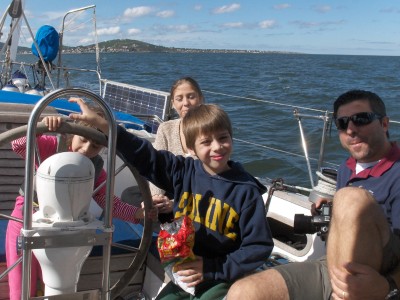
After our “holiday” in La Paloma we returned to our berth in Montevideo (Buceo) for another two months. This time though we found it a little too quiet on account of the seasonal exodus from the city for January and February.
We were waiting though until the travel hoist in next small port, Piriapolis , was overhauled so that we could lift and anti-foul there. We were doing a fast scrub down and anti-foul job and for that we found the facilities perfect. The hard area is clean, water pressure good , and the climate in March made for great drying conditions.
Apparently if you need a certificate to weld, or use outside contractors then the pace of things can be a bit exasperating . That though may well be changing as there is a new “kid on the block” an Irishman, Laurence. He is both a naval architect and is well versed in repairs and maintenance of all types of boats and systems.
We managed to get lifted, cleaned, five coats of paint on and back in the water in a week. The first sail with a clean bottom was down to Mar del Plata at the southern mouth of the Rio Plate. And what a sail, we logged our first 180 mile day in what were relatively light conditions and I caught a nice “pez limon” , yellowtail, into the bargain.
Mar del Plata, well what can I say. If you can imagine the biggest, most over concreted sea side resort that you know and multiply it by two orders of magnitude, you might get some idea of this enormous and ugly resort. It is where the masses of Buenos Aries and the people from the interior cities decamp to for their summer holidays, as many as ten million of them at a time.
The yacht basin tucked into the corner of what is Argentina’s largest fishing port is a seclude world of it’s own. It is shared by four or five sailing and fishing clubs and home to a couple of particularly large sea-lions. The port area and it’s high street are very normal and it would make a good provisioning stop if you were heading south for Patagonia.
As soon as we were acclimatised to Argentina we sailed up the Plate for Buenos Aries. What a city, big, full of culture, easy to find your way around and just so much to do. We extended our courtesy week at Yacht Club Argentina by another few days and really enjoyed the city. We experienced the annual remembrance of the “disasparidos” and were very moved by the strength of feeling and anguish on display and the determination that nothing so brutal would ever be allowed happen again.
The “portenos” as the city dwellers are know, are infinitely patient and polite while dealing with the human congestion that is part and parcel of life in such a large city. They queue and queue, they squeeze over in the buses and “subtes” , they help each other with bicycles and prams and they wait for the public performances put on by the city for their entertainment.
If you want to enjoy the city though you should put yourself through a special “time conditioning” before arrival. Friends meet for dinner no earlier than ten o’clock, they go out for tango or other music about one, when they get more than four hours sleep I don’t know. It is a seriously late culture.
We moved to the suburbs north of the city to another yacht club to stock up on non perishables and bits and pieces for the boat. It was a bit of a come down after our city centre experience and if we return we would berth further up , maybe at Tigre to have better access to the delta.
April came and with it Eileen’s departure to Ireland. She needed to see family, to touch base with Connemara and in all likely hood to get a break from our 24/7 on board life.
I began the journey back up the South American coast with a run back to Piriapolis. The plan was to find guests/crew for each part of the passage and I was successful in getting crew for this first leg.
It was good to be back in Uruguay after the month in Argentina, a slower easier way of life.
Piriapolis harbour was nicely busy with boats arriving from both Brasil and from Patagonia. While I was looking for people for the next leg a delivery job came up and so I did sail north from Piriapolis before the weather got cold, directly to Grenada but without En Passant.
The delivery was a Leopard catamaran that was being traded in for a new, larger one by a Uruguayan owner. It was interesting to take a different boat on a passage that I was about to embark on with En Passant. My impression was that in the conditions we experienced (a week of close hauled, some good reaching and a thousand miles of down wind trades ) was that En Passant would have won the race by a few days. Although it would have been a fairer “race” if we had had a gennecker for those light wind trade days on the catamaran.
My only real complaints were the noise of the hulls slapping when we were doing good speed and the difficulty of translating good speed into good daily distances. The challenge off the wind is to get the catamaran to steer straight enough.
On the plus side, I didn’t spill a single cup of coffee in over four thousand miles !
It is the solstice today. En Passant is experiencing a winter solstice as she is still moored in Piriapolis, Eileen is experiencing a “proper” summer solstice as she is back in Connemara at 54 north and I am in a solstice free zone here in the Caribbean.
The plan is for all three of us to be re-united in Natal, Brazil, in October. In the meantime I have to fly back down to Uruguay, jump on board En Passant , and get moving up to Brazil before I feel the mid-winter cold.
A Balinearo Christmas
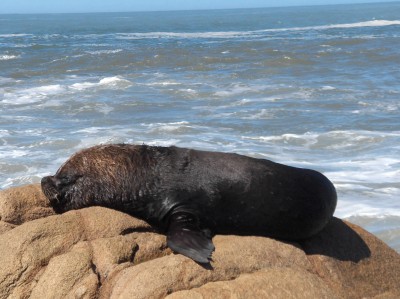
A deadline, definitly something that we are not used to anymore but Eileen has a gig playing in a restaurant in La Paloma on the 23rd Dec. Tomas and Claudia our German friends arrive half shattered by bus from Buenos Aries the evening before. It is all hands on deck, fridge full of food and tanks full of water in the morning and despite our best efforts we are a few hours late leaving, queues in the bank last minute shopping coupled with inertia, are to blame. The almost three months without going for a sail are telling but we get the head sails bent on and the fours ropes shackled to the buoys off with nothing worse than the loss overboard of an old friend, an adjustable spanner.
Or so I thought, Tomas picks up two plastic parts off the deck and asks me what they are. They turn out to be bushings from the head sail roller reefing which we can now see has two sections pulled apart after the jib hoisted. Sail on in ten knots of wind or turn back? I go aloft and decided that in worst case scenario will require me top sides to furl or drop the headsail. A couple of tacks later the foils have dropped back into place so all is well and we can furl if needed.
After a warm moon light night sail we are only off Punta del Este with forty five miles to go by eight o'clock. Our anti -fouling is definitely a thing of the past and our dirty hull is seriously slowing us down but we must have a serious current in here of the endless beach as well. As a reminder never to sail to a deadline the easterly wind picks up to twenty five knots and we motor sail on eventually making harbour at eleven, too late for Eileen's gig but not too late for her to get there and apologise. She returns half an hour later with a seven night booking.
La Paloma is slowly, very slowly, gearing up for the main season that will start the first week of January. In the meantime it is wonderfully quite, beaches almost deserted, shopping easy and the port is well a real treat. We are moored bow in to a well sheltered t shaped quay. There are a few small yachts on moorings, three yachts for Christmas neighbours and lots of small gill netters landing each day. It is so good to be in a mixed fishing and recreational harbour. The new quay draws evening anglers, locals and tourists alike hoping to land silver scabbard fish as the light dies.
We have a French-Spanish family as next door neighbours. Two Argentinian yachts make up the small live aboard community and with the help of Eileen's music we are all friends before New Year.
The more we look around La Paloma, the shops scattered among the central few blocks, the library, a few basic mechanical services, the beaches, the cooling Easterly breeze, the holiday suburbs in the pines the more we like it. The port is a shadow of it's former glory, the railway tracks overgrown but it is still alive and there are plans to redevelop it as a deep water port for the timber industry. In the meantime I am reminded every day of the smaller Irish fishing ports in the eighties. There is still enough fish to go around and some of the forty foot gill netters land big catches of dogfish, angel sharks and corvina. Like Ireland twenty years ago there is no sign of a fisheries officer checking quality or recording the landings despite their being no less than five government agencies with offices and staff on hand. It also reminds me of the way we were with fish in Ireland, catch loads of it, handle it badly and sell it cheap. I know that it can't last, the slow growing, slow reproducing species like dogfish will disappear and the lesson of smaller landings, discriminatory gear like long-lines, of properly iced and handled fish landed for better prices will be too late to save the stocks and the fishermen.
We reluctantly head back towards Montevideo after a great three weeks of , well , holiday. A gentle two day sail under spinnacker with an over nighjt stop for a good sleep anchored off Isla Garitta (of Punta del Este) and we are back in Peurto Buceo. Unfortunatly there is not enough water to get into our comfortable berth behind the pier but only have one rolly night in the harbour mouth. The wind shifts obligingly to the SE and blows enough water up the Plate for us to get moored snugly behind the pier the next evening.
Uruguay First Impressions
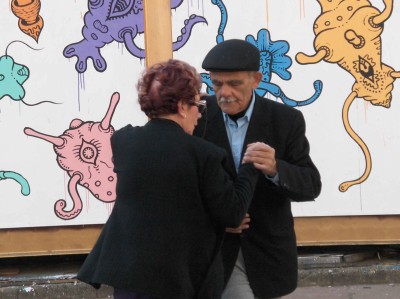
City life offers different things and we have been offered and accepted a half year membership to the Yacht Club Uruguayo. A 24/7 launch service in and out to the boat, gym, pool and a postal address are new luxuries but they free up access for Eileen allowing her to come and go to work. We are getting over our aversion to that four letter word and Eileen was teaching English and cafe singing within a week of arriving in Montevideo.
Peurto Buceo is located between the upmarket suburb of Pocitos and the "World Trade Centre" which is reminiscent with it's new edificios of Dublin's Financial Services Centre. The promenade, the Rambla, runs west the ten kilometres into the old city and another fifteen east along the suburbs and beaches. There is a bus terminus two hundred metres away and street markets every other day within easy walking distance, complete the facilities.
In other words if you have to moor up in a city for a few months then this is about as good as it gets.
The Montevideans we meet are calm, interested and educated. Their modesty and general interest in the wider world are in stark contrast to most Brazilians that we encountered. I suppose that goes with the territory, Uruguay is a small country wedged between two large neighbours, one formerly a powerhouse the other currently an economic tiger. Montevideans hold their own by being careful, a little understated, slightly reserved but very open once you have an introduction. They treat each other with wonderfully warm greetings and seem content to suck mate or a quiet beer by the beach. They prefer to listen to tango instead of dancing madly to it and will listen to music rather than talk over it. Apparently though there is a shift in national character for carnival...... I'll pass judgement after I experience it.
Services and shops (well my kind of shops) are specialised and it takes a fair bit of time and walking in the commercial district to tick off the list of bits and pieces needed for jobs on the boat. That said if you can find the right shop then they will have almost everything in their area of specialisation. The "rubber" shops stock everything from O rings to brake pedal covers, from industrial sheeting to car door seals and from grommets to castrating rings.
Weekend markets are big and full of new and used clothes, hardware, books and junk. The municipality in Parque Rodo hosts outdoor music alongside the Sunday market but there is not a lot of street entertainment. The bus drivers allow buskers, preachers and sellers on for a few stops to make their pitch and Montevideans listen and applaud.
Christmas is almost on us and Eileen's teaching and exam supervision is over for the holidays. It seems as if the city will empty for at least the first two weeks of January and for longer for those that can afford it. The world and his mother head east to the "Baleniaros" or seaside resorts which vary in popularity depending on your age group and level of "coolness" you desire. The most upmarket and de rigour is Punta del Este, frequented in January by the rich and famous and wannabees of Uruguay and Argentina. We are going to head east too for a couple of weeks, further along the coast to La Paloma. Cruising friends who have been in Buenos Ares for the past year are coming with us. Despite some slow progress on my "to do list" I am happy to pack away the tools and boat parts shopping lists and Eileen is especially ready for a holiday.
Leaving Pasadise
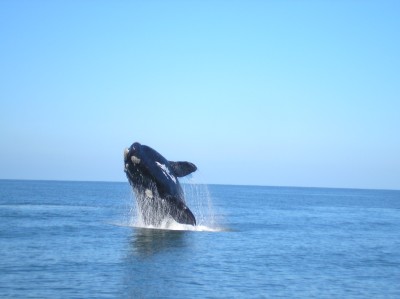
Living our quiet life, moving anchorages every few days around Ilha Grande, a trip to town every three or four weeks was enough. We would anchor off Abrao so that I could catch the morning ferry to Angra Dos Reis. The area has no regular wind in the winter and it was quicker and cheaper to take the ferry than motor En Passant over there.
The return ferry trip was always a worthwhile experience, the isles and seats stacked with shopping. The chicos who pack your supermarket shopping are expert at filling the big clear polythene bags so that all the heavy stuff sits evenly at the bottom and the bags stand up properly without tipping over.
The ferry gets you to town in time for an eleven thirty coffee and then you have to put your skates on to gather most of a month's supplies together before it leaves again at three thirty. Three hours or so to; get around the supermarket, the health food store, eat lunch and finally the vegetable shop. Leaving your supermarket shopping for delivery is an act of trust. One expedition had me a bit rattled when the ferry was revved up and the ropes loosened before two lads came breathlessly on board with my thirty kilos or so of shopping, the delivery van had disappeared and they had to use a private car to make the delivery.
Lunch in the bakery is taken standing at the counter, an empanada or a slice of a savoury pie followed by a piece of cake and coffee. I had first encountered Brazilian coffee making, when we were hiking in Chapada Diamantina. Our guide, Carlos, would sit a muslin sieve of ground coffee over the saucepan with it tail hanging in the boiling water, to stiffen the brew up to the desired strength he would draw the bag back and forth across the pot. The old bakery in Angra uses the same method except the muslin strainer was much bigger and the hot water was in a tall, battered "Burco" style boiler with taps. These filter bags look like the dust collectors from vacumn cleaners but they make grit free coffee. Coffee is usually served already sugared and is treated as an essential "quick fix" not something to savour or linger over. Cola is the preferred method of caffeine intake.
A final stocking up day in Angra and we are ready to leave paradise and head to the hopefully not too chilly Rio Plate. It seems hard to believe that we have been hanging out here for over four months and that Eileen and En Passant have not left the island for the last two. The island is definitely been the most alluring place so far, I have already decided to return.
The two day wait for a more favourable forecast allowed us a full moon b-b-q on the beach with Stronglegs. Jack at twelve years old is in his element, stoking the fire, crawling through the water to launch surprise attacks and eating all around him.
The GRIB files promise three or four days of easterly wind once we get clear of the island and so we text and e-mail Ricardo who wants to come with us. He has recently acquired a Formosa 46, an almost sister ship of En Passant and needs some offshore experience. He hopes that his kids will agree to a year off school so that they can do a cruise to Europe the year after next.
Ricardo turns up from Rio on Sunday morning and we are ready except let's wait until this sudden downpour finishes. We motor the three miles to the western tip of the island and get sailing. We watch the island disappear astern and start to get into passage mode. It is nice to have an extra crew member on board for a change and Ricardo is very keen to learn. I learn as well, that is I found out that he has never spent a night at sea before. I must remember that question when assessing potential crew in the future!
Two days out and still no sign of the fresh easterlies we were hoping for. Our speed is up and down, broad reaching mostly but we were going at fish speed this morning, over the magic six knots and landed a fine Dorado, at least fifteen kilos. It is good to be back on the ocean and we have my first ever albatross for company along with a jet black shearwater. A whale astern in the evening and Ricardo was fascinated on his evening watch by the "fire dolphins", wonderfully light up with phosphorescence.
Head winds and that are fresh enough for a second reef. There had to be a reason why all the Argentinean sailors I talked to said don't bother going down until November when you get the north easterlies. We ploughed on slowly, keeping her comfortable and not worrying about an extra day or two for the passage.
That was all very well until we suddenly came clear of a bank of cloud and the wind just stopped. We are five days out and just about half way. I had told Ricardo to expect a seven day passage, possible shorter. He was ok as he had discovered the joy of Sailmail and could keep in touch with his wife. He was taking in information like a sponge and was plotting his own positions on paper and on his laptop after two or three lessons.
We had to give in on day eight and start the engine again. We are now in very "thick" green estuary water and despite being over a hundred miles off land it is only thirty metres deep. The plentiful albatrosses and shearwaters of the last few days are joined by penguins. We pass groups of four or five every few hundred metres, it is flat calm and none of the birds are catching anything.
My turn in the galley and I am making lunch when Eileen calls "whale". Sure enough there are big splashes and dark shapes a half mile off to the south. I alter course and then stop two hundred yards away from them. What unusual behaviour, two, three and four whales at a time waving their flippers in the air and swimming so close together that we think that they might be mating.
I switch the engine off and we try and count how many there are, eight or nine is the consensus. Then three of them turn and swim deliberately over to us. I am definitely nervous when they pass within a metre along our side but they are moving very slowly and calmly, whew.
I am back below with my cooking when Eileen shouts again, no wonder one of them is breaching about two hundred metres away, six great lunges out of the water followed by a tail slapping show that would put Moby Dick to shame. These definitely are the "Right Whales" to watch. We are completely mesmerised by time and are treated to another breaching show but this one finishing close enough to splash us.
I am so glad that I had not seen the "Right whale lands on yacht" video on YouTube before our own experience with these wonderfully, interested and interesting Southern Right Whales. We left them reluctantly and as we motored away two of the pod followed and then passed very close under our hull before turning back. That was definitely a two way "watching" experience, have a look at them at; http://www.youtube.com/watch?v=aK3W680Fne4 .
We motored on in the calm, but were not going to make La Paloma, the first harbour in Uruguay, before nightfall and so with a favourable breeze sailed on through the night heading for Piriapolis. A day of flying first the gennecker and then the spinnaker brought had us abeam of Piriapolis that evening.
We saw our first seals since leaving Ireland. It seems incredible that seals are all but extinct in the Canaries, Azores and Madeira . They don't occur in tropical Atlantic waters and it was good to see their heads bobbing in the water again.
Ricardo was not sure of his route home but thought that Montevideo would be his best bet, and as we were all enjoying the sailing we continued east another night and entered Buceo harbour in the suburbs of Montevideo, Uruguay's capital at eight o'clock the next morning.
Moored close by the busy pilot-boats berth and with commuter traffic streaming into town along the Rambla two hundred metres away , it is quite a change from Ilha Grande. The other big change is the sea, here it is 10 C, brackish and murky, a far cry from the 22 C salty water we left behind in Brazil eleven days ago, brrrr.
